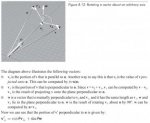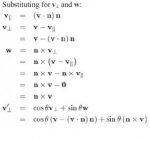

Hello. I am wondering if anyone can help me understand a particular step in the derivation of a matrix to rotate a vector around an arbitrary axis that passes through the origin. The book I am reading shows how to derive a formula to rotate a vector about a unit vector n by theta degrees. Using this formula, we plug in the vectors representing the x, y and z axes as unit vectors, and use the resulting rotated basis vectors as row vectors for 3x3 matrix. The matrix part I sort of understand, but the part where they derive the formula to rotate an arbitrary vector is not making sense.
I have attached two pictures that shows how they derive the formula to rotate a vector. I am stuck on understanding the following part:
My first thoughts were some manipulation of law of sines/cosines because in the figure(8.12) they provide, theta seems to be larger than 90 degrees. So it seems like the usual trigonometric relationships really wouldn't help here(SOH CAH TOA). If this is the case, I can't figure out how they applied law of sines/cosines here.
The rest of the derivation goes:

If needed, I can explain or post what they did in the section they refer to(5.10.3) where they describe how to separate a vector into parallel and perpendicular components for projection onto another vector.
If anyone's curious, the book is 3D Math Primer for Graphics and Game Development by Fletcher Dunn and Ian Parberry.
